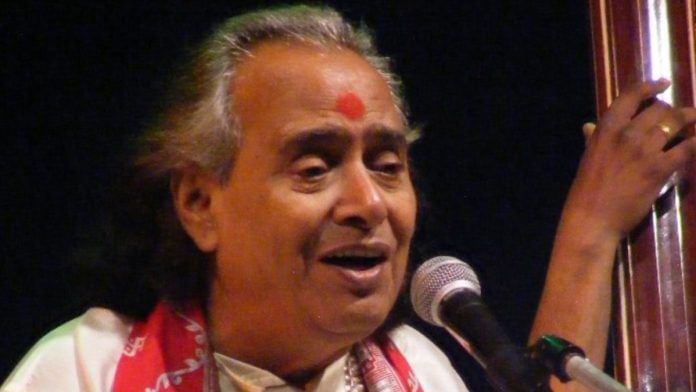New Delhi: Pandit Chhannulal Mishra, doyen of the Kirana Gharana whose voice carried both the majesty of a raga and the tender devotion of the Ramcharitmanas, passed away at 4.15 am in Uttar Pradesh’s Mirzapur. Often described as the very voice of the Ramayan Katha, at 89, his ashes were immersed in the Ganga at Manikarnika Ghat—the sacred river he sang of all his life.
A Padma Bhushan, Padma Vibhushan, and Sangeet Natak Akademi awardee, he was celebrated for blending the majesty of khayal, the delicacy of thumri, and the devotion of Tulsidas’s Ramcharitmanas with equal brilliance. His unique gift lay in weaving music with storytelling, turning every raga and bhajan into an experience of history, scholarship, and devotion. For Banaras, he was not just an artist but its soul, giving voice to its traditions, its rivers, and its faith.
Despite performing across India and abroad, Mishra remained deeply humble, soft-spoken, and rooted in simplicity. His life was marked by profound losses, including his wife and daughter during the pandemic, yet his devotion to music and disciples never waned.
“His passing leaves an irreplaceable void in Indian classical music. As one of the last great doyens of the Banaras Gharana, he carried a legacy whose loss is immeasurable,” said F Wassifuddin Dagar, Dhrupad singer.
Scholar and storyteller
His father, Badri Prasad Mishra, introduced him to Hindustani classical music, and his marriage into the family of Anokhilal Mishra, another eminent musician, deepened those roots.
What set him apart, however, was his ability to blend scholarship with song. He sang the Ramayana as though it were unfolding in real time. He could move seamlessly from the delicacy of a thumri to the meditative depth of a Kirana khayal, interspersing his music with stories and reflections that left audiences spellbound.
“He had the strength of seven swaras and seven Ramayana kathas,” said Rashmi Malik, the chairperson of SPIC MACAY Foundation. “He never taught harshly; he taught with love. Every composition carried a story, and behind every note was the knowledge of a lifetime. He wasn’t just a musician; he was one of the greatest scholars of the Ramayana.”
Malik recalled that whenever he sang, his music left people stunned—it spoke for itself. And when he explained with rare clarity, audiences realised they weren’t just listening to music but experiencing history, devotion, and wisdom.
Also read: Jane Goodall—no formal degree, no laboratory, only passion for the wild
Last great voice of Banaras
In 1936, in Hariharpur, Azamgarh, he grew up in a home steeped in music and went on to become a scholar-performer who could render the Ramayana as though it were unfolding in real time. His thumris bore the earthy Purab Ang of eastern Uttar Pradesh, his khayals the contemplative depth of Kirana, and his bhajans the devotion of Tulsidas. When he sang the Sunderkand or the Hanuman Chalisa, temples turned into kathas—Ram’s exile, Sita’s longing, Hanuman’s devotion—all brought alive in the moment.
His career reached far beyond Banaras. He performed across the world, lent his voice to films like Aarakshan. Yet he remained disarmingly simple, soft-spoken, humble, never angry. For his disciples, he was not just a guru but a father figure, teaching with affection rather than sternness. “Every note carried the wisdom of a lifetime,” said Rashmi Malik. “He wasn’t just a musician; he was a true scholar of the Ramayana.”
Mishra’s life was also marked by piercing loss. The deaths of his wife, Manorama Devi and daughter Sangeeta during the Covid-19 pandemic left a grief that never left him. Frailty followed in his later years, when his meals were reduced to khichdi, ghee, and milk, yet his mind remained fixed on music, disciples, and Banaras.
Condolences poured in after his passing. Prime Minister Narendra Modi hailed him as “a lifelong devotee of Indian art and culture,” while President Droupadi Murmu remembered him as “a beacon of the Banaras Gharana.” For Malik, the grief is more intimate: “He loved me like a father. His music was scripture, and his humility was his greatest legacy.”
(Edited by Saptak Datta)






